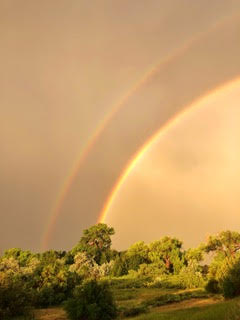by Laura Gonzales, Education & Volunteer Manager
“A storm on the Llano is beautiful…A feeling of gladness comes over one as the heavens open to bathe Mother Earth. Only those ever watching and waiting for the rain can feel the rapture it brings.”
—Fabiola Cabeza de Baca, We Fed Them Cactus
 Every New Mexican knows there’s nothing quite like afternoon storm clouds rolling in and quenching the sun-baked earth with cool summer rain. Especially appreciated during periods of drought, nothing is more anticipated than monsoon season and the relief it brings to the Land of Enchantment.
Every New Mexican knows there’s nothing quite like afternoon storm clouds rolling in and quenching the sun-baked earth with cool summer rain. Especially appreciated during periods of drought, nothing is more anticipated than monsoon season and the relief it brings to the Land of Enchantment.
New Mexico has withstood several periods of drought with some of the worst years on record being the 1870s–80s, the 1930s, and the 1950s (arguably the worst). With little precipitation since winter, much of the state has been thrust into drought conditions again, so let’s hope for a generous monsoon season!
“Monsoon,” from the Arabic “mausim,” means “season,” and since New Mexico’s monsoon runs from June through September, perhaps it’s fair to say we are currently in the middle of our “season” season. This natural phenomena occurs when a wind shift over a region is accompanied by moisture. For New Mexico, if the shift is good, it accounts for nearly half of the state’s annual precipitation.
As beautiful and necessary as they are, summer storms have their share of hazards. If you can hear thunder, you’re probably within striking distance of lightning. While a lightning show is mesmerizing to the eye, they can be deadly. The National Oceanic & Atmospheric Administration (NOAA), reports roughly 25 million lightning ground strikes in the United States each year! Since 1959, nearly 100 people in New Mexico have been killed, ranking the state 21st in lightning deaths. Did you know that the air within a strike can heat up to 50,000 degrees Fahrenheit? That’s hotter than the sun! One strike can generate enough electricity to power a light bulb continuously for 3 months.
While less frequent than lightning storms, floods can be even more devastating. In New Mexico, 1941 was the year “it didn’t stop raining.” Flooding washed out bridges and roads, destroyed structures and farmland, and even severed gas lines. One report stated that the flood forced a woman into a tree, which she shared with 3 rattlesnakes for 12 hours. She stated “the snakes were there first, and despite knocking 2 of them off with a stick, they both promptly climbed back.” That year, 28 people died from weather-related deaths, 24 in the flood, and the state saw an average of 26.25 inches of rain — double the normal average — making it the wettest year on record.
The best way to avoid lightning and flash floods during monsoon season is by staying alert. Keep up with weather reports, avoid seeking refuge under trees or standing in an open field, don’t use a corded telephone, avoid metal fences, and, especially important in New Mexico, be aware if walking or playing around an arroyo. Take precautions and enjoy the beauty of the storm from a safe place. Remember, when thunder roars, go indoors!
Sources:
https://www.weather.gov/abq/preplightning
https://www.drought.gov/drought/states/new-mexico
https://www.sscafca.org/know-your-arroyos/

